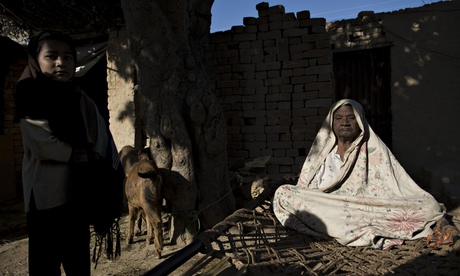
Child, early and forced marriage and female genital mutilation (FGM) are firmly under the spotlight at the UK government's Girl Summit this month, with both practices gaining increased recognition as barriers to both women's rights and sustainable development. But we need to move beyond the girl-centred dialogue often dominating these discussions and gain greater understanding of the role of mothers and grandmothers.
Found in diverse cultures across the globe, child marriage statistics show that one in three girls in the developing world are married by age 18, while one in nine are married by age 15. Some girls are married as young as eight or nine. FGM is found mainly in parts of Africa and the Middle East and the World Health Organisation estimates between 100 and 140 million women worldwide have been subjected to at least one of the first three steps of female genital mutilation.
Older women are sometimes at the core of such practices because they have been socialised into the patriarchal systems that uphold detrimental gender norms. "Decision-making processes for FGM are often led by older female relatives, including mothers and grandmothers, as they have the sole responsibility of making this happen as a sign of fulfilling their social responsibility", explains Naana Otoo-Oyortey, executive director of Forward, whose work on FGM specialises in community engagement.
The centrality of mothers and grandmothers role means that they also have the potential to be disrupters. The Grandmother Project works in Senegal to strengthen communication between generations of women and also to empower grandmothers to influence male and community members towards stopping such practices. "In some cultural contexts where family decision making is collective, grandmothers play an influential role given their experience," says executive director Judi Aubel. "Conversely, it is extremely difficult for younger women, and especially for adolescent girls, to influence those decisions. It is in fact, a grandmother's culturally designated responsibility to pass on such traditions."
Girls not Brides has reported on the dangers of demonising families for continuing these practices. "Families practicing child marriage are not 'evil,' sending their children away because they don't care," says the campaign group. "Rather, they are operating within a system in which these early marriages are meant to protect the daughters they hold dear. Focusing on reasons that families practice child marriage opens up a range of possibilities to stop it." Child marriage and FGM are underpinned by a range of triggers from poverty to codes of honour and unquestioned norms integral to community identity.
Empowering girls directly has been a focus in much programming to combat these practices, and indeed, strengthening the agency of girls is central to ending them. However, girls do no not exist in a vacuum; they reside within familial relationships that have nurtured them, and the consequences of acting alone in a manner considered deviant cannot be ignored.
"We can't talk about empowering the girl child without involving the society she grows up in," says Rainatou Sow, founder and executive director of Make Every Woman Count. "It is very important to involve the community as a whole, so we need a holistic approach that addresses harmful practice and makes sure that the girl child can grow healthy and empowered within her community."
Indeed, this juxtaposition between a girl's individual sovereignty to resist harmful practices and a community's importance as a home and lynchpin of a girl's identity is difficult enough in a country like the UK, where at least emergency services, the force of law and greater access to information can to a certain extent offer some support. For many girls across Africa, Asia, and the Middle East, the circumstances are shakier.
"Many laws prohibiting FGM and child marriage in Africa coexist alongside customary laws therefore nullify the effectiveness of those laws," says Naana Otoo-Oyortey, who also highlights the importance of governments committing to human rights frameworks to address this tension.
At the community level, ensuring that girls are not left isolated is critical. Just as working with men and boys is pivotal to bringing about sustained change on these issues, ignoring or underestimating the role of older women would be extremely naïve.
"The alienation of those who are viewed as being cultural authorities can lead to the further entrenchment of those same harmful traditional practices," cautions Judi Aubel. "We believe that girls cannot change norms on their own and that one of their greatest needs is to have a supportive social environment around them, and that those who can best support them are other women."
The speedy transience of girlhood alongside what are often short-term girl-empowerment interventions also needs acknowledgment. Girls become women quickly in these contexts, and some will pass beyond the reach of targeted programming even before completion of the baseline research. Many will become mothers and even grandmothers themselves in short spaces of time. With that in mind, enabling women to form a compact of protection for their daughters and granddaughters is a powerful way forward.
Fatimah Kelleher is an international social development consultant and writer. Follow @fatimahkelleher on Twitter.
Read more stories like this:
• Why should the British public care about FGM?
• Girls brave violence for their education in northern Nigeria
• Six innovations for ending violence against girls
Join the community of global development professionals and experts. Become a GDPN member to get more stories like this direct to your inbox

